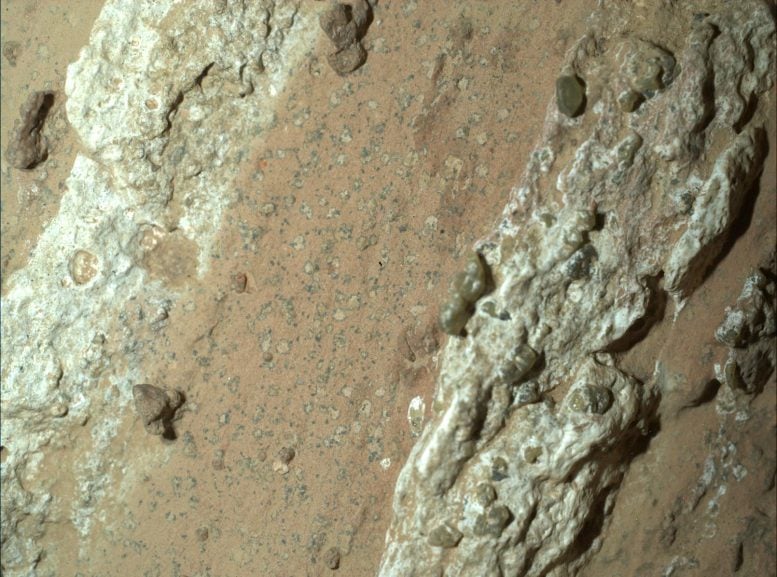
NASA’s Perseverance rover has uncovered mysterious mudstones in Mars’ Jezero Crater that contain organic carbon and strange mineral textures.
These features, possibly shaped by redox reactions similar to those fueled by microbes on Earth, may represent potential biosignatures.
Perseverance Rover Uncovers Organic-Rich Mudstones
Images and measurements from NASA’s Perseverance rover indicate that recently identified rocks in Jezero Crater are composed of mudstones containing organic carbon. According to a study published in Nature, these rocks underwent chemical reactions that produced colorful and unusual textures, which may represent possible biosignatures.
The research, led by Joel Hurowitz, PhD, an Associate Professor in the Department of Geosciences at Stony Brook University, builds on studies carried out since the rover touched down in 2021. The work focuses on reconstructing Mars’ early geological history and gathering samples that could eventually be transported back to Earth.

Geological Survey of the Bright Angel Formation
When Perseverance reached the western edge of Jezero Crater, it examined distinct mudstone outcrops in the Bright Angel formation. The Mars 2020 science team performed an in-depth geological, petrographic, and geochemical analysis, uncovering carbon material along with minerals such as ferrous iron phosphate and iron sulfide.
Although the researchers are not announcing the discovery of fossilized Martian life, they note that the rocks display features that might have been shaped by living organisms – what scientists call potential biosignatures. A potential biosignature is any element, compound, structure, or pattern that could have originated from past biological activity, but which could also arise without life. The team emphasizes that further evidence is needed before determining whether microbes played a role in forming the textures seen in these mudstones.
A Window Into Mars’ Ancient Environment
“These mudstones provide information about Mars’ surface environmental conditions at a time hundreds of millions of years after the planet formed, and thus they can be seen as a great record of the planetary environment and habitability during that period,” says Hurowitz, who has been involved with Mars rover research since he was a graduate student at Stony Brook University in 2004.
“We will need to conduct broader research into both living and non-living processes that will help us to better understand the conditions under which the collection of minerals and organic phases in the Bright Angel formation were formed,” he explains.
Untangling Biological vs. Abiotic Origins
More specifically, the researchers concluded the following during their analyses:
- The organic carbon detected appears to have participated in post-depositional redox reactions that produced the observed iron phosphate and iron sulfide minerals. And these reactions occurred in a sedimentary rock environment at low temperature. Redox reactions are a type of chemical reaction that all living things derive energy from, and in low temperature sedimentary environments on Earth, these redox reactions are commonly driven by microbial life.
- A review of the various pathways by which redox reactions that involve organic matter can produce the observed suite of iron, sulfur, and phosphorus-bearing minerals reveals that both abiotic (physical not biological) and biological processes can explain the unique features observed in the Bright Angel formation.
- Their observations in the Bright Angel formation challenge some aspects of a purely abiotic explanation, and thus the researchers suggest that the iron and sulfur and phosphorus-bearing nodules and reaction fronts should be considered a potential biosignature.
Next Steps: Unlocking Secrets on Earth
Continued research will be done to assess the rocks and mudstone features. For the time being, the researchers ultimately conclude that analysis of the core sample collected from this unit using high-sensitivity instrumentation on Earth will enable the measurements required to determine the origin of the minerals, organics, and textures it contains.”
Explore Further: NASA Perseverance Rover’s Stunning Find May Be Mars’ First Sign of Life
Reference: “Redox-driven mineral and organic associations in Jezero Crater, Mars” by Joel A. Hurowitz, M. M. Tice, A. C. Allwood, M. L. Cable, K. P. Hand, A. E. Murphy, K. Uckert, J. F. Bell III, T. Bosak, A. P. Broz, E. Clavé, A. Cousin, S. Davidoff, E. Dehouck, K. A. Farley, S. Gupta, S.-E. Hamran, K. Hickman-Lewis, J. R. Johnson, A. J. Jones, M. W. M. Jones, P. S. Jørgensen, L. C. Kah, H. Kalucha, T. V. Kizovski, D. A. Klevang, Y. Liu, F. M. McCubbin, E. L. Moreland, G. Paar, D. A. Paige, A. C. Pascuzzo, M. S. Rice, M. E. Schmidt, K. L. Siebach, S. Siljeström, J. I. Simon, K. M. Stack, A. Steele, N. J. Tosca, A. H. Treiman, S. J. VanBommel, L. A. Wade, B. P. Weiss, R. C. Wiens, K. H. Williford, R. Barnes, P. A. Barr, A. Bechtold, P. Beck, K. Benzerara, S. Bernard, O. Beyssac, R. Bhartia, A. J. Brown, G. Caravaca, E. L. Cardarelli, E. A. Cloutis, A. G. Fairén, D. T. Flannery, T. Fornaro, T. Fouchet, B. Garczynski, F. Goméz, E. M. Hausrath, C. M. Heirwegh, C. D. K. Herd, J. E. Huggett, J. L. Jørgensen, S. W. Lee, A. Y. Li, J. N. Maki, L. Mandon, N. Mangold, J. A. Manrique, J. Martínez-Frías, J. I. Núñez, L. P. O’Neil, B. J. Orenstein, N. Phelan, C. Quantin-Nataf, P. Russell, M. D. Schulte, E. Scheller, S. Sharma, D. L. Shuster, A. Srivastava, B. V. Wogsland and Z. U. Wolf, 10 September 2025, Nature.
DOI: 10.1038/s41586-025-09413-0
Never miss a breakthrough: Join the SciTechDaily newsletter.
1 Comment
Perhaps something was left out because the organic carbon was not specifically identified. And of course iron sulfates or sulfides contain no carbon so they cannot be considered a potential bio signature.